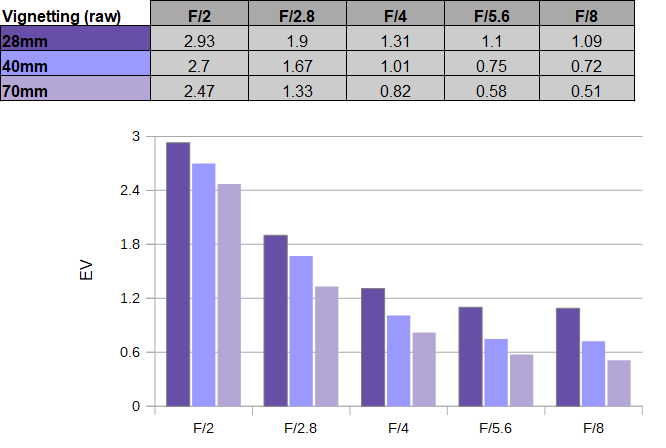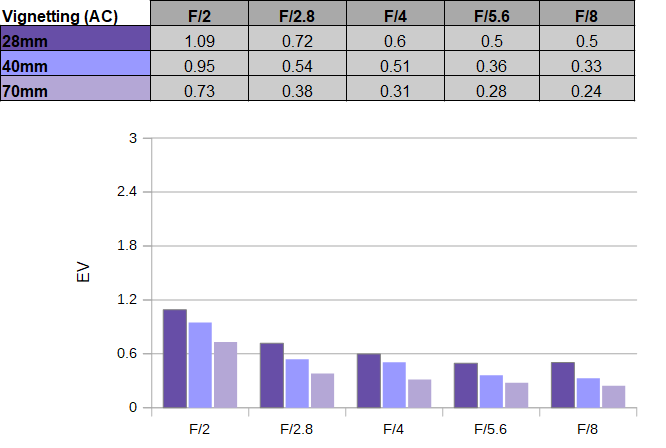|
Canon RF 28-70mm f/2 USM L - Review / Test Report - Analysis |
|
Lens Reviews -
Canon EOS (Full Format)
|
|
Page 2 of 3

Distortion
The Canon RF 28-70mm f/2 USM L produces a medium barrel distortion of 2.8% at 28mm. Images are pretty much distortion-free around 40mm and the distortions increase towards slight pincushion type at 70mm.
Of course, this is all mostly irrelevant (other than a slight decrease in corner resolution) with activated image auto-correction as you can see below.
Vignetting
The native vignetting characteristic is on the high side but this is to be expected regarding the large max aperture. At f/2 the light falloff peaks at almost 3 EV (f-stops) at 28mm f/2 and it's just marginally less at 40mm and 70mm. Stopping down to f/2.8 reduces the issue by about 1 EV and it's mostly acceptable from f/4 onward.
 Once again, if you prefer to activate image auto-correction, the algorithm reduces the fall-off substantially, although you may still spot a bit at f/2.
Once again, if you prefer to activate image auto-correction, the algorithm reduces the fall-off substantially, although you may still spot a bit at f/2.

MTF (resolution at 45 megapixels)
The Canon RF 28-70mm f/2 USM L delivers great quality even on a high-megapixel sensor. The sweet spot is at 28mm, where the results are impeccable at all settings. This remains mostly true at 40mm. The broader center is a bit better still, whereas the outer image field is a tad worse at 40mm f/2. There's a more noticeable drop at 70mm. The center quality is still excellent, but the corners are "merely" good to very good here.
The field curvature is low. The centering quality of the tested sample was good.
Please note that the MTF results are not directly comparable across the different systems!
Below is a simplified summary of the formal findings. The chart shows line widths per picture height (LW/PH) which can be taken as a measure of sharpness.
If you want to know more about the MTF50 figures, you may check out the corresponding Imatest Explanations

MTF (resolution at 30 megapixels)
If you are using a lower-megapixel body, the subjective quality perception will be even better, of course. The results are just stellar at 28mm and 40mm. The slight decrease in quality in the outer image region at 70mm is also present here but the resolution is still very good.

Chromatic Aberrations (CAs)
Lateral CAs (color shadows in the outer image field) are exceptionally low at all aperture and zoom settings.

Bokeh
The primary differentiator of the RF 28-70mm f/2 USM L is, of course, its speed. f/2 is fast even by prime lens standards, and besides its primary optical characteristics, it's also the bokeh that this lens is all about.
Out-of-focus highlights show a subtle onion-like substructure - probably related to the 3 aspherical elements in the design. There is no obvious outlining at the edges. The highlights remain circular from f/2 to f/4 - thanks to the 9 rounded aperture blades.
 The shape of the highlights tends to deteriorate towards the image corners - due to mechanical vignetting. However, the Canon behaves better than most in this respect in that the shape deteriorates "late". As you can observe below, only the corner highlights are "cut". Stopping down f/2.8 restores the corner highlights already.
The general rendition in the focus transition zones isn't perfect but still quite smooth both in the background (to the left below) as well as the foreground (to the right).
The shape of the highlights tends to deteriorate towards the image corners - due to mechanical vignetting. However, the Canon behaves better than most in this respect in that the shape deteriorates "late". As you can observe below, only the corner highlights are "cut". Stopping down f/2.8 restores the corner highlights already.
The general rendition in the focus transition zones isn't perfect but still quite smooth both in the background (to the left below) as well as the foreground (to the right).

Bokeh Fringing (LoCA)
Bokeh fringing - also referred to as LoCAs - is a color fringing effect on the Z-axis. It shows up as purplish halos in front of the in-focus zone and greenish beyond. The effect is visible at f/2. Stopping down to f/4 reduces the fringing to a negligible degree. Keep in mind that bokeh fringing is normal in all but a handful of very expensive APO lenses.
|